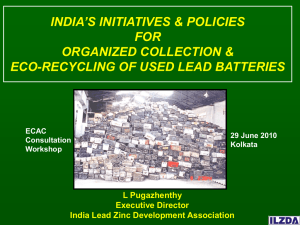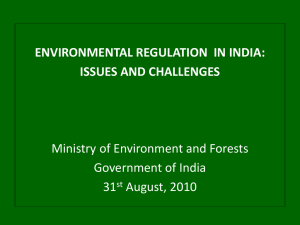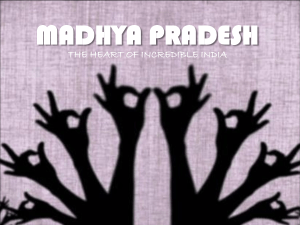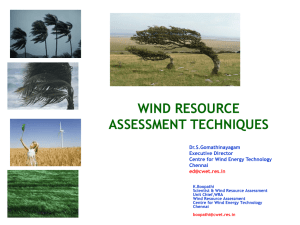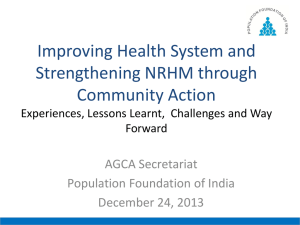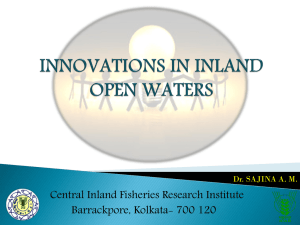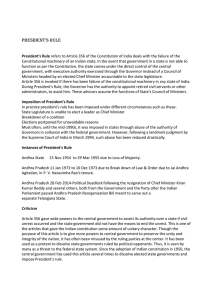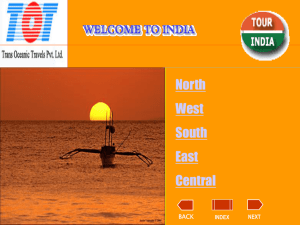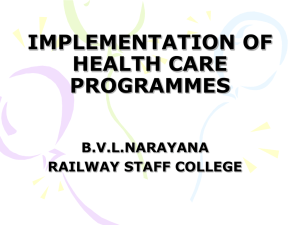(a) 17 categories of Highly polluting industries, (b)
advertisement
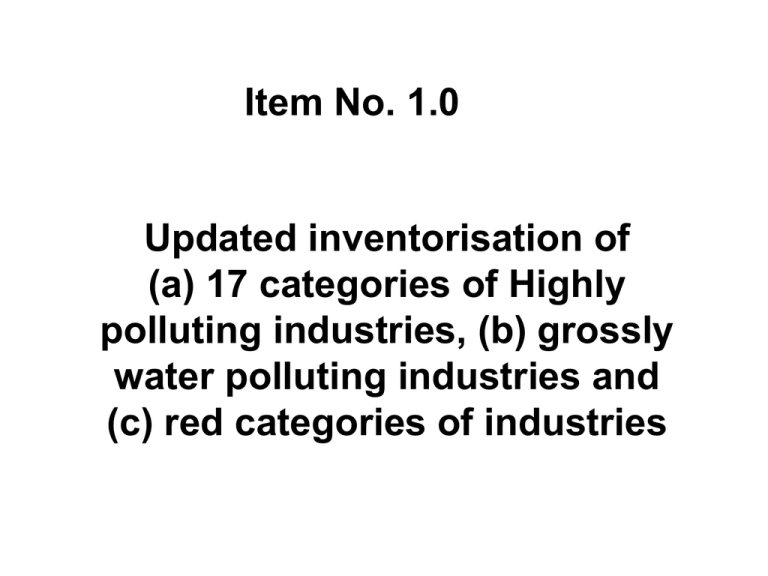
Item No. 1.0 Updated inventorisation of (a) 17 categories of Highly polluting industries, (b) grossly water polluting industries and (c) red categories of industries NEED OF UPDATED INVENTORIZATION Formulation of policy Monitoring of enforcement and compliance Reply of Parliament questions , RTI applications , PIL & Court cases. Departmental documentation Updation of information on website 17 CATEGORIES OF HIGHLY POLLUTING INDUSTRIES MoEF issued a notification on January 16, 1991 to ensure compliance of environmental standards in polluting industries. MoEF formulated 15 point programme for priority action. CPCB selected 18 Categories of major polluting industries and after discussion 17 Categories of highly polluting industries are finalized for regular follow up through CPCB. [ Removed Sulphuric Acid Plants as it is a part of Fertilizer plants / Smelters ] PRESENT STATUS – 17 CATEGORIES OF INDUSTRIES [COMPILED BY CPCB ON THE BASIS OF INFORMATION RECEIVED TILL DATE ] 2526 Industries are identified , out of which, 2050 are operational and 476 closed. 1796 [88% ] are complying and 254 [12 % ] are defaulters (i.e. were not meeting the standards during last monitoring) Direction under Section 18(1)(b) of Water and Air Acts issued for conducting half yearly monitoring and submitting the status in prescribed format. (Annexure-V of Agenda). Some SPCBs/PCCs have submitted updated information, and information awaited from other SPCBs / PCCs. GROSSLY POLLUTING INDUSTRIES (GPIS) GPIs - Industries discharging effluents into a water course and (a) handling hazardous substances, or (b) effluent having BOD load of 100 Kg per day or more, or (c) a combination of (a) and (b). In 1993-94, CPCB initiated identification of industries along the rivers to control industrial discharges into rivers. The National River Conservation Authority (NRCA) in its meeting dated July 12, 1997 directed to install the requisite effluent treatment systems in industries located on the bank of water-bodies. In compliance of above, CPCB issued directions under Section 18(1) (b) of The Water Act, 1974, to all the SPCBs/PCCs on July 14, 1997, for inventorization of GPIs and initiating action against the defaulting industries. PRESENT STATUS OF GPIS [ COMPILED BY CPCB ON THE BASIS OF RECEIVED INFORMATION] 1453 Industries are identified, out of which 1177 are operational and 275 closed. 986 [84% ] are complying and 191 [16%] are defaulters (i.e. were not meeting the standards at the time of last monitoring) SPCBs/PCCS were directed to carry out Quarterly monitoring and submit the status to CPCB in prescribed format (Annexure-VI of Agenda). Some SPCBs/PCCs have submitted the updated information and is awaited from other SPCBs / PCCs. Concerned SPCBs/ PCCs are requested to submit the updated information in prescribed formats in hard and soft copies at the earliest. SPCBs/PCCs are also requested to ensure online submission of updated information of 17 Categories of Industries and Grossly Polluting Industries on regular basis. INVENTORISATION OF RED CATEGORIES OF INDUSTRIES • In 46th Conference of the Chairman and Member Secretaries held in July 1998, “Guidelines for management of Consent and Directions” were framed. • Total 71 red categories (including 17 Categories and GPIs) of industries were identified and the list was circulated to all SPCBs/PCCs. • The list of remaining 54 Red categories [excluding 17 categories] of industries is available in CPCB. • CPCB issued directions under section 18 (1)(b) of the Water Act, 1974 and the Air Act, 1981 to all SPCBs/PCCs to submit the compliance status of the large and medium industries of 54 Red Categories. INVENTORISATION OF RED CATEGORIES OF INDUSTRIES Every State Pollution Control Board/Pollution Control Committee has its own list of Red Category Industries other than the categories identified by CPCB. SPCBs were requested to update the list to maintain uniformity in categorization of such industries at national level. Proposals were asked for inventorization and updation of list and data available with SPCBs. Proposals from Rajasthan, Madhya Pradesh, Assam, Goa and Mizoram have been received and is awaited from other SPCBs / PCCs. The uniform list will be prepared with the help of a working group of State Boards of West Bengal, Maharashtra, Orissa, & Madhya Pradesh FIFTEEN POINT ACTION PLAN (1991) 1. Implement pollution control by December 31, 1991, in identified large and medium units in the 17 highly polluting sectors, including revision of consent conditions by April, 1991 (S.C. No.23, dated 16.1.1991). 2. Bring all polluting units within the ambit of the regulation by requiring them to take a consent to operate. 3. Promote the setting up of common effluent treatment plants in clusters of small scale industrial units. 4. Lay stress in enforcement of heavily polluted areas where injury to health and damage to the environment is becoming apparent and environmental restitution is needed. 5. Implement the Public Liability Insurance Act. 6. Review the stay orders granted by the High Courts, and other courts, and file appeals to prevent the polluters from continuing to pollute. 7. Increase assessment and collection of water cess as an incentive to the polluters to install treatment plants. 8. Prepare an awareness building campaign. 9. Institutional development of the State Pollution Control Boards, particularly improving training and functioning of laboratories. 10.Review of monitoring arrangements, including data and location of stations. 11.Preparation of a computerized data base. 12.Development of standards. 13.Review of progress in: i. Adoption of the Water (Prevention and Control of Pollution )Amendment Act, 1988 and notification of rules there under by the States of Madhya Pradesh, Orissa, Manipur, Arunachal Pradesh, Bihar, Gujarat, Haryana, Karnatka, Kerala and West Bengal. ii. Notification of rules under the Water Amendment Act, 1988 by the States of Assam, Goa, Himachal Pradesh, Andhra Pradesh, Maharashtra, Mizoram, Rajasthan, Sikkim. Tripura, Tamil Nadu and Uttar Pradesh. iii. Adoption of the Water Act, 1974 and constitution of a State Board under the Water and Air Acts by the State of Nagaland. iv. Notification of Rules under the Water (Prevention and Control of Pollution) Act, 1974 by the States of Tripura, Manipur, Mizoram, Sikkim and Arunachal Pradesh. v. Implementation of Hazardous Waste Management and Handling Rules, 1989. vi. Installation of automatic air monitoring equipment by the major polluting units. vii. Notification of air pollution control areas. 14. Review of directions issued under the Environment (Protection) Act, 1986. 15. Review of the audit of Annual Statement of Accounts and preparation of the Annual Report of the State Pollution Control Boards. Click here 17 CATEGORIES OF HIGHLY POLLUTING INDUSTRIES 1. 2. 3. 4. 5. 6. 7. 8. 9. 10. 11. 12. 13. 14. 15. 16. 17. Aluminium Smelting Basic Drugs & Pharmaceuticals Manufacturing Chlor Alkali/ Caustic Soda Cement (200TPD and above) Copper Smelting Dyes and Dye Intermediate Fermentation (Distillery) Fertiliser Integrated Iron & Steel Leather Processing including Tanneries Oil Refinery Pesticide Formulation & Manufacturing Pulp & Paper (30 TPD and above) Petrochemical Sugar Thermal Power Plants Zinc Smelting Click here STATUS OF 17 CATEGORIES OF HIGHLY POLLUTING INDUSTRIES Name of the State/ S.No. Complying Defaulting Closed Union Territory 1 ASSAM 19 2 __ 2 ANDHRA PRADESH 305 8 52 3 BIHAR 17 1 1 4 CHATTISGARH 70 5 __ 5 GOA 14 1 ___ 6 GUJARAT 142 53 60 7 HARYANA 82 14 34 8 HIMACHAL PRADESH 12 2 2 9 JAMMU & KASHMIR 7 __ 3 10 JHARKHAND 22 __ 5 11 KARNATAKA 119 9 12 12 KERALA 25 9 15 13 MADHYA PRADESH 42 18 5 14 MAHARASHTRA 237 8 69 15 MEGHALAYA 8 4 16 MIZORAM 1 __ __ 17 ORRISA 38 7 8 18 PUNJAB 54 5 18 19 RAJASTHAN 80 4 75 20 TAMIL NADU 191 ___ 32 21 TRIPURA 8 1 __ 22 UTTRANCHAL 21 17 2 23 UTTAR PRADESH 219 71 58 24 WEST BENGAL 54 10 21 25 CHANDIGARH __ __ 1 Total 21 365 19 75 15 255 130 16 10 27 139 49 65 314 12 1 53 77 159 223 9 Click 40 here 348 85 1 SPCBS/PCCS-17 CAT. Sl. No 1 2 3 4 5 6 7 8 9 10 11 12 13 14 15 16 17 18 19 20 21 State Andhra Pradesh Assam Bihar Gujarat Haryana Jharkhand Karnataka Kerala Madhya Pradesh Meghalaya Rajasthan Tripura Uttar Pradesh Daman Delhi Pondicherry West Bengal Mizoram Orissa Sikkim Himachal Last Report Received February 18, 2008 February 14, 2008 December 12, 2009 June 12, 2008 July 21, 2008 February 13, 2008 February 06, 2008 March 15, 2008 February 18, 2008 June 09, 2008 March 12, 2008 February 19, 2008 February 29,2008 January 01, 2008 February 21, 2008 March 03, 2008 23 Dec, 2009 March 05, 2008 March 03, 2008 March 05, 2008 September 06, 2008 Date of last Reminder May 24, 2010 May 24, 2010 May 24, 2010 May 24, 2010 May 24, 2010 May 24, 2010 May 24, 2010 May 24, 2010 May 24, 2010 May 24, 2010 May 24, 2010 May 24, 2010 May 24, 2010 May 24, 2010 May 24, 2010 May 24, 2010 May 24, 2010 May 24, 2010 May 24, 2010 May 24, Click 2010 here May 24, 2010 SUMMARY STATUS OF GROSSLY POLLUTING INDUSTRIES Sl. No. 1. 2. 3. 4. 5. 6. 7. 8. 9. 10. 11. 12. 13. 14. 15. 16. 17. 18. 19. STATE /UT Andhra Pradesh Assam Bihar Chhattisgarh Gujarat Haryana Jharkhand Karnataka Kerala Madhya Pradesh Maharashtra Orissa Pondicherry Punjab Tamil Nadu Uttar Pradesh Uttarakhand West Bengal DD & DNH TOTAL Total 17 9 22 1 3 76 5 10 36 1 214 20 1 20 366 569 49 32 2 1453 Complying 11 9 16 1 2 71 2 8 18 1 139 6 1 9 248 391 29 22 2 986 Closed 6 0 6 0 0 1 0 1 7 0 2 5 0 4 118 116 4 5 0 275 Defaulting 0 0 0 0 1 4 3 1 11 0 73 8 0 7 0 62 16 5 0 191 Click here INFORMATION AWAITED FROM SPCBS/PCCS-GPI Sl. No 1 State Andhra Last Report Received Reminders given 04.03.2008 17.06.2010 Pradesh 2 Assam 03.03.2008 17.06.2010 3 Haryana 01.09.2009 17.06.2010 4 Karnataka 01.06.2009 17.06.2010 5 Kerala 2008 17.06.2010 6 Daman 2008 17.06.2010 7 Maharashtra 04.03.2008 17.06.2010 8 Chhattisgarh 2008 17.06.2010 9 Tamil Nadu 2008 17.06.2010 Click here LIST OF 54 CATEGORIES OF INDUSTRIES 1. 2. 3. 4. 5. 6. 7. 8. 9. 10. 11. 12. 13. 14. 15. 16. 17. 18. 19. 20. 21. 22. 23. 24. 25. 26. Anodizing Asbestos and asbestos based industries Automobiles Manufacturing /assembling Ceramic/refractories Chemical, petrochemical and electro chemicals including manufacture of acids such as sulphuric acid, nitric acid, phosphoric acid, and so on Chlorates, per-chlorates, and peroxides Chlorine, fluorine, bromine, iodine, and their compounds Coke making, coal liquefaction, coal tar distillation or fuel gas making Common effluent treatment plant Dry coal processing/mineral processing industries like ore sintering, palletisation, and so on Explosives including detonators, fuses, and so on Fermentation industry including manufacture of yeast, beer, and so on Fire crackers Foundries Glass and fiber glass production and processing (excluding molding) Glue and gelatin Heavy, engineering Hospitals Hot mix plants Hydrocyanic acid and its derivatives Incineration plants Industrial carbon including electrodes and graphite blocks, activated carbon, carbon black, and so on Industrial or inorganic gases namely : Chemical gases: acetylene, hydrogen, chlorine, fluorine, ammonia, sulphur dioxide, ethylene, hydrogen sulphide, phosphine, (b) hydrocarbon gases: methane, butane, ethane, propane Industry or process involving electroplating operations Industry or process involving foundry operations Industry or process involving metal treatment or process such as pickling, paint stripping, heat treatment, phosphating or finishing, and so on 27. 28. 29. 30. 31. 32. 33. 34. 35. 36. 37. 38. 39. 40. 41. 42. 43. 44. 45. 46. 47. 48. 49. 50. 51. 52. 53. 54. Lead re-processing and manufacturing including lead smelting Lime manufacturing Lubricating oils, greases or petroleum-based products Milk processing and dairy products (integrated project) Mining and ore-beneficiation Organic chemical manufacturing Parboiled rice mills Paints and varnishes (excluding blending/mixing) Petroleum products manufacturing and oil/crude oil/residues reprocessing Phosphate rock processing plants Phosphorous and its compounds Photographic films and chemicals Pigments and intermediates Potable alcohol (IMFL) by blending or distillation of alcohol Power generating plants (excluding DG sets) Processes involving chlorinated hydrocarbons Ship breaking Slaughter houses and meat processing industries Steel and steel products including coke plants involving lose of any of the equipment’s such as blast furnaces, open furnace, induction furnace or an arc furnace and so on, or any of the operations or processes such as heat treatment, acid pickling, roiling or galvanizing, and so on Stone crushers Surgical and medical products involving prophylactics and latex Synthetic detergent and soap Synthetic fiber including rayon, tyre cord, polyester filament yarn Synthetic resins Synthetic rubber excluding molding Tobacco products including cigarettes and tobacco processing Vegetable oils including solvent extracted oils, hydrogenated oils Yarn and textile processing involving or any effluent /emission-generating process Click here
